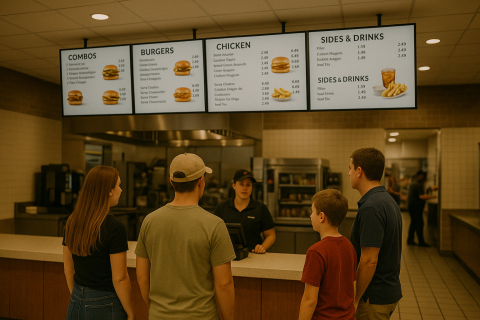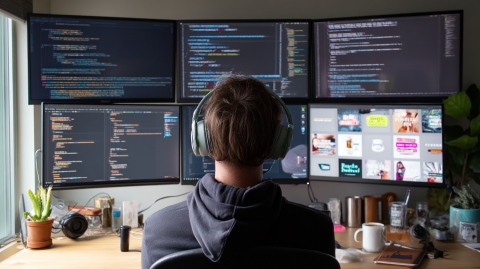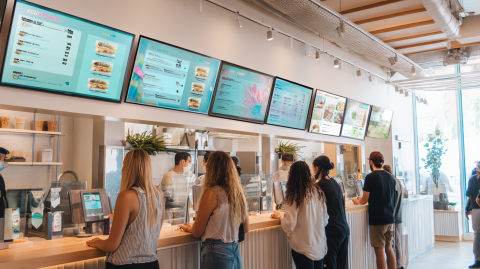Quick service restaurants (QSRs) operate in a fast-paced environment where every second counts. Whether you’re running a burger joint, a coffee shop, or a taco stand, you know how important it is to keep menu boards up-to-date and customers happy. But updating traditional signs or printed menus can be a headache. This is where digital signage comes in as a game-changer for QSRs. In this blog post, we’ll explore how deploying and managing digital menu boards in a QSR is now easier than ever – and how Screenly’s friendly, plug-and-play solutions can help improve customer service, enhance customer experiences, increase sales, reduce wait times, and enable real-time menu updates. Grab a snack, and let’s dive in!
Why digital signage for QSRs?
Digital signage isn’t just a flashy tech upgrade – it directly addresses common challenges in quick service restaurants. Here are some key benefits of switching to digital menu board displays in your QSR:
Better customer service: Digital signs can streamline the ordering process. For example, screens can display order numbers or status, so staff don’t need to shout out when an order is ready. This reduces confusion and creates a smoother, more customer-friendly experience at the counter. When customers can easily see menu options and order status, your team can focus on serving food and answering fewer repetitive questions – a win for customer service efficiency.
Enhanced customer experiences: Bright, dynamic displays with mouth-watering visuals make waiting in line a bit more enjoyable. Compared to static posters, digital boards can show delicious animations or rotating images of each menu item, catching customers’ attention. In fact, restaurants that use digital screens see higher customer engagement and recall. One study found that digital displays in restaurants increased customer recall rates by up to 47%, meaning people notice and remember your content. Entertained and informed customers are happier customers, which keeps them coming back.
Increased sales and promotions: Eye-catching digital menu boards don’t just look good – they can help drive impulse buys and upsells. With the flexibility to highlight menu items (like a limited-time dessert or a combo upgrade) at the perfect moment, you can gently influence what customers order. On average, businesses have seen sales increase by around 31.8% after implementing digital signage. QSRs can use this to their advantage by promoting high-margin items or daily specials prominently on the screen. The result? Customers are more likely to add that side dish or try the new item, and your revenue gets a tasty boost.
Reduced perceived wait times: No one likes to wait, but digital signage can make waiting feel shorter. By displaying engaging content – from fun facts to social media feeds or mouth-watering videos – you keep customers occupied and less aware of the clock. Research shows digital signs can cut perceived wait times by around 35%, making lines feel faster. Additionally, clear digital menus can help people decide on their order more quickly, moving the line along. Shorter wait times (or at least the feeling of shorter waits) lead to more satisfied guests.
Real-time updates and flexibility: Perhaps one of the biggest advantages for QSR operators is the ability to update content in real time. Sold out of a menu item? No problem – simply hide or replace it on the screen. Need to switch from the breakfast menu to the lunch menu at 11:00 AM on the dot? It can happen automatically with scheduled content. The era of printed posters and static signs is fading fast. Major fast-food and coffee chains already use digital menu boards that can change based on the time of day or inventory levels. For example, a breakfast menu can seamlessly swap to the lunch menu at 11am, and pricing or items can update on the fly as needed. The result is not only a more engaging, up-to-date menu for customers, but also easier item and price updates for your staff and managers. In short, digital signage gives you the power to be nimble – adapting to everything from current promotions to unexpected stock issues, across one or many locations, with just a few clicks.
As you can see, switching to digital signage in a QSR delivers a better experience for customers and makes life easier for the business. Now, let’s talk about how Screenly makes deploying and managing these digital signs truly effortless.
Deploying screens without the hassle
One reason some restaurant owners hesitate to adopt digital menu boards is the fear that it’s technically complicated or requires a big upfront investment in new hardware. Screenly solves these worries with a plug-and-play approach to deployment.
Screenly’s digital signage players: If you prefer dedicated hardware, Screenly provides compact digital signage players that are simple to set up. These little devices hook up to your existing TVs or monitors (via HDMI) and connect to the internet. It’s as easy as plugging in a streaming stick – no technical expertise required. Once connected, the player will download your content and start showing your menu and promotions on the screen. Because Screenly’s platform is cloud-based, you don’t need to manually load media with USB sticks or constantly tend to the device; it’s largely “set it and forget it.” In fact, Screenly’s robust solution lets your staff manage screens from a central web interface, so you can deploy a device and then manage it remotely. Many users find that after the initial setup, they can literally focus on running the restaurant while the digital signs take care of themselves – the screens reliably play the right content at the right times without constant manual intervention.
Screenly Anywhere: Don’t have a dedicated media player device? No problem – Screenly has a unique solution called Screenly Anywhere that allows you to deploy digital signage on any device with a web browser. This means your smart TV, a spare tablet, an old laptop, or a mini PC can become a digital menu screen without any specialized player hardware. In other words, you can launch your first screen in minutes by just opening a link. Screenly Anywhere is a browser-based player that is hardware-agnostic, allowing you to get up and running fast and cost-effectively. There’s no need to wait for shipping or purchase new equipment if you already have a capable screen on hand. For a busy QSR, this is a big deal – you could roll out digital menus to all your franchise locations using existing TVs, all through a simple web app, ensuring a quick deployment across the board.
Because the Screenly platform is cloud-based and built for user-friendliness, deploying a new screen – whether with a Screenly player or via Screenly Anywhere – is straightforward. Many QSR operators are pleasantly surprised that what they assumed would be a high-tech headache is actually as simple as “plug in, connect, and go live.”
Effortless content management from anywhere
Getting your screens up is just step one – the real magic is in how easily you can manage and update your content. This is where Screenly truly shines, making content management a breeze even if you’re overseeing digital signage for multiple restaurant locations.
Centralized cloud management: With Screenly’s web-based dashboard, you can control one screen or hundreds from a single login. All you need is an internet connection to push new content or changes. For example, you (or your team) can update a menu from anywhere – whether you’re on-site at the restaurant or at a central office miles away. This remote content management means no more rushing USB sticks to every store or having staff manually change each screen. You can update prices, swap out an image, or post a new special in seconds via the online interface, and it will roll out to all your chosen screens. This saves a ton of time and labor. Think about the old way: if you had 50 locations, updating a breakfast item’s price might have meant 50 separate visits or a lot of shipped posters. With Screenly, it’s one click – 50 screens updated. Your staff stay off ladders and your customers aren’t staring at “black screens” while updates happen. The content updates are seamless and can even be scheduled to occur in off-hours to avoid any disruption.
Easy scheduling & dayparting: QSR menus change throughout the day – breakfast, lunch, dinner, late-night, etc. Manually swapping menus is a hassle (and forgetting to do it on time can confuse customers). Screenly’s scheduling tools take care of this automatically. You can set up a playlist or schedule so that your digital menu board content changes at preset times. For instance, schedule the breakfast menu to display from 6am to 10:59am, then have the lunch menu kick in at 11:00am, and so on. The transition will happen on schedule without you lifting a finger. Have different menus on weekends or special holiday menus? Those can be pre-programmed as well. Screenly’s built-in playlist feature is sophisticated enough to handle multiple menu variations and dayparts – all you do is set it once, and it will automatically show the right menu at the right time. This ensures customers are always seeing the appropriate offerings (no more people trying to order breakfast at 2pm because the sign didn’t change!). It also reduces stress for staff, since they don’t need to remember to update screens manually. In short, scheduling makes your content timely and relevant all day, every day.
Instant promotions and real-time changes: Because everything is managed in the cloud, you can react to events in real time. If a certain ingredient runs out at 2pm, you can quickly hide that item from the menu to set proper expectations. If weather suddenly turns cold and you want to promote hot coffee and soup, you can push a new promo graphic to all screens immediately. Some QSRs even integrate live data – for example, a local sports score ticker during big games, or linking the menu to a database so that menu items automatically gray-out when unavailable. Screenly’s platform is robust and even supports Edge Apps and integrations for those who want to get creative. Edge Apps allow you to build custom signage applications and integrate third-party data into your screens easily. Imagine displaying a live social media feed of customers enjoying your food, or an up-to-the-minute countdown on a limited-time offer. With Screenly’s low-code Edge Apps framework, it’s possible to craft these kinds of dynamic experiences without needing to be a software wizard. The best part is that these apps run natively on the device, so even if your internet goes down, your screen can keep showing content without a hitch. While not every QSR will need to build custom apps, it’s nice to know the option is there to really tailor your digital signage to your restaurant’s needs.
Monitoring and reliability: Managing digital signage isn’t just about the content; it’s also about making sure your screens are up and running when you need them. Screenly includes features for monitoring your screens’ health in real time. You’ll get visibility into whether a screen is online and what’s playing. If something goes wrong (say a screen goes offline or there’s a power issue), you’ll know right away through the dashboard. This proactive monitoring means you can often fix an issue before it becomes a problem noticeable to customers. High reliability keeps your digital menu boards displaying and your customer experiences consistent. After all, a blank screen or error message during the lunch rush is the last thing you (or your hungry patrons) want to see.
Overall, managing content with Screenly is designed to be so easy that one person can handle the digital signage for an entire chain of restaurants. For example, a marketing manager at headquarters can centrally update content for all franchises, ensuring brand consistency and timely promos everywhere. This frees up local staff to focus on on-site customer service, while the screens handle the standardized messaging. Your digital signage basically becomes a well-oiled machine that runs in the background, supporting your business goals with minimal upkeep.
Ready to get started?
Get started with Screenly today, and serve up a modern menu experience that will keep guests coming back for more. Your restaurant’s digital transformation is just a few clicks away. Sign up for a 30-day free trial.





